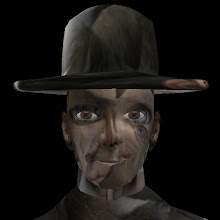AngryBeth Shortbread pointed out the Jedi nature of my master apprentice rants. The fact that my youngest lad has had all 6 episodes of Star Wars on a continuous loop for the last year may well have influenced me slightly.
The other thing that I have realised about the master apprentice model is that it does not work on its own. In fact, ironically enough, it's something that I have been sort of fighting against on the course that I teach on. Let me explain.
On our course, each student is assigned a personal tutor. The vast majority of input that a student gets is from this tutor. Invariably, this master influences their apprentice, inducting them into the ways of the force as they see it. What often happens is that the apprentice turns into a mini-me, a watered down version of the original. The master is invariably disappointed in this sub-standard clone. This is the first danger of the master apprentice model. The second danger is that a student may end up with a tutor that isn't really that interested in that student's practice, and the tutor that is into that student's practice is in a different year, and not accessible. The pressure to adapt the practice to pleases your tutor is tremendous, and damaging. In short, when the 'master apprentice' model gets mixed up with the 'manager of learning' role of a tutor, things ain't good.
The solution? To separate out these two distinct roles, and make sure that each tutor knows when they have the media neutral, manager of learning hat on, and when they are a master, expanding their practice and inspiring all who witness their greatness, unrestricted by the practical day-to-day needs of students.
The way that I have tried to do this on our course is to introduce a week-on, week-off system. In the first week, I see all of my 28 graphics students face-to-face, and I go to wherever they are, teasing them forward into the zone of proximal development. Any sense of my own practice is not allowed. It's about them in week one. In the second week, I am the master, and any student from across the whole of the School that happens to have an interest in mad virtual art and bad/good creative programming can seek me out and share my joy. So the 'master apprentice' model, and the 'zone of proximal development' model are two sides of the same coin. Students need both equally, and staff need to do both equally.
The two projects that we will be running during the pilot reflect both the zone and the master apprentice models. The first project (zone) asks the students to build a shrine to their avatar. This is all about going to the student and drawing out of them what they are really about, and what they potentially might become. The second project (master apprentice) is to make some art for an exhibition that Kisa and Cubist are preparing work for. This is about students working along-side us, learning by example, witnessing good practice and being able to imagine themselves playing the part of the artist. If they play that part well enough, they become the artist, and their work will hopefully sit along-side ours in the actual exhibition.
Subscribe to:
Post Comments (Atom)
Idea Stains
-
▼
2008
(94)
-
▼
April
(11)
- Obi-Wan has taught you well, but you are not a Jed...
- Revised A&D Pilot Plan
- Talk to strangers
- Intellectual property rights & copyright issues wo...
- The Immersionist vrs the Augmentists (or is it Aug...
- Avie tracking radar
- Between OpenSim and Second Life - IBM take the lead
- The master/apprentice model
- The ideal art-school studio-workshop.
- A MUVE is not a tree.
- Long live OpenSim. Down with Second Life!
-
▼
April
(11)

No comments:
Post a Comment